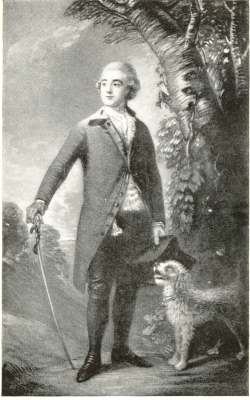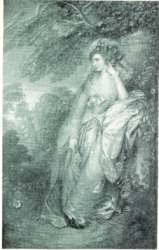Sir Henry Bate Dudley
b. 28 August 1745 d.1 February
1824 - Author, Rector, Magistrate and Squire
Sir Henry combined the roles of Rector and
Squire of Bradwell on Sea from his home at Bradwell Lodge.

Sir Thomas Bate Dudley painted by
Gainsborough
He was the second child in a family of 12
born to Rev Henry Bate who was the incumbent at North Fambridge
parish church although his family hailed from Worcestershire.
Henry was educated at Queen's College, Oxford
and ordained by the Bishop of London in 1772 serving his curacy at
Leatherhead and then Hendon. While he was at Hendon he met David
Garrick, Bonnel Thornton,George Selwyn , Colman Cumberland,
William Hogarth , William Shields and Thomas Gainsborough. When his
father died in 1775 Henry has inducted to the living at North
Fambridge. He does not appear to have played a large role in the
life at North Fambridge using the income to support his brothers and
sisters.
He remained in London becoming editor of the
Morning Post which became famous for its daring approach to social
and political matters. After falling out with the backers of the
Morning Post Henry worked for several other newspapers. In
1780 he continued to cement his place in society by marrying Miss
Mary White whose sister was the famous actress Mrs Hartley.

Lady Mary Bate Dudley as painted by
Gainsborough
Three portraits of Sir Henry and one of his
wife Mary by his friend Thomas Gainsborough passed through several
hands before they were bought for the nation and now hang in the
National Gallery.
He earned the nickname ' the fighting parson'
by taking part in two duels. The first duel was settled with pistols
following a Morning Post article about the Countess of Strathmore.
The second followed remarks made by Henry at two Dragoon Officers
concerning remarks made about Mrs Hartley. The duel was eventually
completed with fists which saw Henry triumphing one again to add
further notoriety to is name.
Henry then made a mistake by publishing an
article concerning the Duke of Richmond who was at the time a
Minister of Ordnance stating that he opposed the strengthening
of England's Defences. The Duke of Richmond took legal action and
Henry was sentenced to 12 months imprisonment.
Once Henry was released he opted for a
quieter life and moved to The rectory at Bradwell on Sea as curate
in 1781 and his name appeared on the Marriage Register for the first
time in 1782 .The Rector of Bradwell was George Pawson but like many
Rectors of his time he visited Bradwell very rarely being content to
take the income but leave the work to his curate.. Henry purchased
the advoson in 1784 which gave him the right to nominate the Rector
of Bradwell .

An etching of Bradwell Lodge made in 1793
after the renovation was complete
Henry made some major improvement to the run
down church. He secured the churchyard by driving out the pigs that
frequented the area and he brought the church up to acceptable
standards. He added a large extension to the Rectory in the belief
that the Prince Regent may visit. The Rectory later became known as
Bradwell Lodge to mark its new grandeur. In the surrounding area he
reclaimed 250 acres of land from the sea, drained the marshy Glebe
land and spent £28,000 which was a large sum of money to improve
local cultivation. By 1797 he owned Delamers , Great Millets, Little
Millets and rented East Hall, Munkens, Hidemans , Pierce Lorkings
and Jordans farms. He lived as much like a squire as a parson and
became very popular in the village.
During the Napoleonic War, Henry was also put
in charge of the defence of the Coastline. A roll was taken of all
who could serve and a Militia raised by ballot . Some reluctant
residents selected in the ballot to be members of the Militia chose
to pay the wife of another resident to serve in their place.
In 1784 he was left a considerable amount of
money in a will with the condition that he added Dudley to his name
and this he became Henry Bate Dudley.
Sir Henry was also a keen master of
foxhounds. His most famous chase ended at Creeksea Church
where the fox scrambled onto an ivy covered buttress on the Church
Roof. The fox was followed onto the roof by Sir Henry and 6
foxhounds to make the kill on the roof of the chancel. Witty as ever
he told the tale to friends with the remark that the fox died
without he benefit of Clergy.
On the death of Rev Pawson Henry presented
himself to the Bishop who would not accept Henry's legitimacy as
amongst other things he farmed the Glebe before induction. Henry
tried to argue his case and was supported by national heavyweights
such as Lord St Vincent but to no avail. The case dragged on and so
a new Rector was appointed by the crown who was to hold the post for
11 years until his death when Henry as presented his brother in law
Richard Birch and became the new Rector.
Between 1775 and 1811 Henry wrote a number of
plays and comic operas most of which were performed on the Theatre
Royal in London. Titles include Henry and Emma , the Rival
Candidates, The Blackamoor Washed White, The Fitch of Bacon, The
Dramatic Puffers , the Magic Picture ,The Woodham and The Travellers
in Switzerland. The phrase 'Wonders will never cease' is
attributed to Sir Henry in a letter to his friend David Garrick who
subsequently used it in his plays.
In 1804 Henry was offered the benefice of
Kilscoran , Chancellor of the Ferms and Rector of Kilglas in Ireland
and moved to Ireland until 1812 when he returned to England to
become Rector of Willingham , Cambridgeshire.
In 1813 The Prince Regent conferred a
Baronetcy on Henry making him Sir Henry Bate Dudley.
Henry was not to enjoy a quiet life as
Rector. In 1816 riots broke out in East Anglia mainly caused by
poverty increased by the return of soldiers at the end of the 21
years of Napoleonic Wars. The situation was especially bad in the
town of Littleport. Henry rode for the town with two armed
detachments led by Colonel Methuen and Captain Wortham to Littleport
where they found the me barricaded inside the George and Dragon
Public House. Henry approached the men and asked them to surrender .
They refused by opening fire from the upper windows. There was an
exchange of fire when ended with the rioters being captured at the
scene or in nearly marshes. Following the Littlebrook Riots a total
of 18 people were arrested for charges ranging from theft to
robbery.
At the subsequent trial 5 men were sentenced
to death, 9 to transportation and the rest to one year in prison.
Sir Henry was thanked by the Jury , presented with a gold cup by his
Bishop and the inhabitants of Cambridge subscribed to purchase a
silver plate to mark his 'very spirited and firm conduct during the
riots'
Shortly after the riots he retired and moved
to Cheltenham where he died aged 79 years.

Postcard of Bradwell Lodge taken
about 1910 during the tenure of Rev Owen
Bradwell Lodge is a former Tudor house that had been part of Henry 8th divorce settlement from Anne of Cleves.
It was extensively extended for Bate
Dudley by the well known architect John Johnson. The Tudor northern
half consists of oak framing resting on a plinth of brickwork. The
newer southern portion is of late classical design fashionable in
the 18th century. There are several beautiful fireplaces that were
the work of designer Angelica Kaufmann and the overall design of
plaster work is believed to have been the work of Robert Adam who
was considered the foremost expert of his day. The building is
topped by a spacious belvedere that proved one on Gainsborough's
favourite painting studios.
To this day Sir
Henry is remembered by the naming of a road in Bradwell on Sea as
Bate Dudley Drive.



